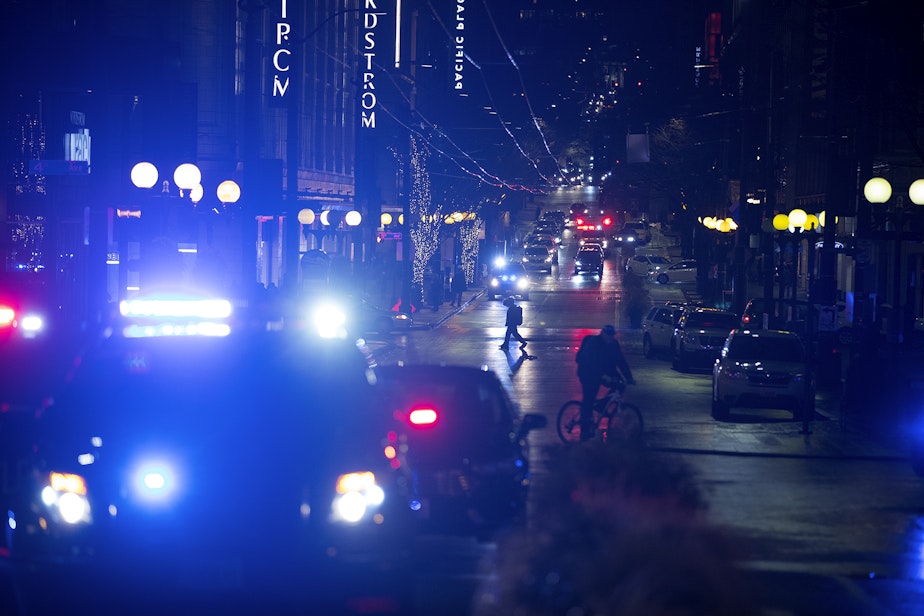How a pandemic and social unrest possibly drove up Seattle homicides in 2020

Seattle Police logged 50 people who were murdered in 2020 — the highest number in 26 years. Experts think a perfect storm of elements from the pandemic to economic turmoil and social unrest could be the reason behind this historic peak.
The first homicide of 2020 took place on New Years, when a 24-year old man was shot in the Pioneer Square neighborhood of Seattle.
That initial death turned out to be one of 50 this past year, a 60 percent increase from 2019, and the largest spike in homicides in a quarter century.
“This is unacceptable,” said Interim Seattle Police Chief Adrian Diaz. “We cannot tolerate this level of violence.”
This rising number in Seattle aligns with a national trend, as other major U.S. cities also report similarly drastic spikes in the murder rate last year.
The deaths in Seattle also follow a troublingly similar pattern to past years.
Sponsored
The majority of the victims, and perpetrators were young men. The majority of the killings were committed with a gun, and half of the victims were Black, despite being seven percent of the population in Seattle.
Jacqueline Helfgott, director of the Crime and Justice Research Center at Seattle University, suggested various factors that may have contributed to this 2020 spike.
“The explanation that I would give in terms of this point in time, locally, and then just looking at what's happening everywhere is that with COVID, and the social movements, the calls to defend the police, the changes in the economic structure for the city -- all of that has contributed to the changes in the crime rates.”
Indeed, 2020 was a year of many historic moments: From the first reported cases of Covid-19 in the nation back in February, to Washington’s stay at home order in March, the death of George Floyd in May and a summer of what may have been the largest protests in U.S. history. High unemployment rates, wildfires that enveloped the West Coast, and a rocky election cycle also intensified stress levels in communities like Seattle and many others across the U.S.
“When you've got people experiencing hardships, when you have people experiencing the kind of anxiety and ambiguity, individuals who I might call ‘edge sitters,’ that can put people over that edge,” says Helgott.
Sponsored
The Washington Department of Health similarly reported that large scale disasters like the pandemic lead to behavioral health issues for communities, and a July report described how people sometimes respond by acting “out” or “in.” While acting ‘in’ leads people to feel depressed, sad, or isolated, acting ‘out’ leads to “increased aggression, hostility, irritability, substance use, and risky behaviors.
“Because of this, law enforcement may see a disproportionate increase in violent crimes,” the DOH report warned.
Another report published in October also noted that political tensions and family gatherings during the holidays were additional factors that could lead to a spike in violence.
Helfgott cautions that while the initial data may seem striking, a closer look is needed to get an accurate picture of what’s happening and how to approach solutions. A domestic violence dispute like the one that took place in the University District in October between a man and his ex-wife differs from the two young men who died in June during the occupation of Cal Anderson park. She said law enforcement, community groups, and policy makers need to distinguish the factors at play in each of those situations in order to make changes.
For Renee Hopkins, CEO of the Alliance for Gun Responsibility, the rise in homicides is not surprising; she sees it as inherently linked with gun violence and gun policy.
Sponsored
“It's really painful proof that the pandemic is exacerbating the gun violence epidemic and not slowing it down,” she said.
Gun sales in Seattle did hit new highs in 2020, once during March when the pandemic began and again in the summer when the protests for racial equity escalated. Public health experts have also warned that more gun sales increase the risk for gun violence.
“The data also show what we already knew to be true, which is the communities that are being disproportionately harmed by Covid-19, are also being disproportionately harmed by gun violence,” Hopkins said “Both the pandemic and the epidemic are hitting communities of color, especially Black communities the hardest.”
While major cities like Seattle, Los Angeles, and Chicago saw high homicide rates in 2020, violent crime rates overall have been in the decline since the 90s. Experts note that this peak, while significant, does not mean a decline in safety overall.
Moving forward in 2021, Hopkins’ organization is working on a number of initiatives to curb the violence. This includes a statewide office that would essentially become a data hub tracking gun violence, high capacity magazine restrictions, and a number of police accountability bills.
Sponsored
Hopkins worries that many of the elements that contributed to a stressful 2020 -- like economic instability and the pandemic -- will continue in 2021, meaning more deaths, a jump in suicides, domestic violence rates, and child abuse.
“I think we would be naïve to think that the rates [of homicides] will just suddenly drop, when many of the factors that people think are contributing to the increase, remain,” she said.




